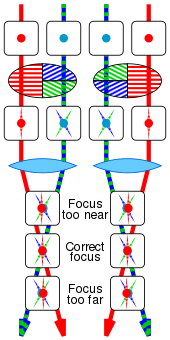Diffraction spike

Diffraction spikes are lines radiating from bright light sources in photographs. They are artifacts caused by light diffracting around the support vanes of the secondary mirror in reflecting telescopes, or edges of non-circular camera apertures.
Diffraction spikes due to support vanes
In the vast majority of reflecting telescope designs, the secondary mirror has to be positioned at the central axis of the telescope and so has to be held by struts within the telescopes tube. No matter how fine these support rods are they diffract the incoming light from a subject star and this appears as diffraction spikes which are the Fourier transform of the support struts. The spikes represent a loss of light that could have been used to image the star.[1][2]
Although diffraction spikes can obscure parts of a photograph and are undesired in professional contexts, some amateur astronomers like the visual effect they give to bright stars – the "Star of Bethlehem" appearance – and even modify their refractors to exhibit the same effect,[3] or to assist with focusing when using a CCD.[4]
A small number of reflecting telescopes designs avoid diffraction spikes by placing the secondary mirror off-axis. Early off-axis designs such as the Herschelian and the Schiefspiegler telescopes have serious limitations such as astigmatism and long focal ratios, which make them useless for research. The brachymedial design by Ludwig Schupmann, which uses a combination of mirrors and lenses, is able to correct chromatic aberration perfectly over a small area and designs based on the Schupmann brachymedial are currently used for research of double stars.
There are also a small number of off-axis unobstructed all-reflecting anastigmats which give optically perfect images.
Refracting telescopes and their photographic images do not have the same problem as their lenses are not supported with spider vanes.

Diffraction spikes due to non-circular aperture
Iris diaphragms with moving blades are used in most modern camera lenses to restrict the light received by the film or sensor. While manufacturers attempt to make the aperture circular for a pleasing bokeh, its shape tends towards a polygon with the same number of sides as blades when stopped down to high f-numbers (small apertures). Diffraction spreads out light waves passing through the aperture perpendicular to the roughly-straight edge, each edge yielding two spikes 180° apart.[5] As the blades are uniformly distributed around the circle, on a diaphragm with an even number of blades, the diffraction spikes from blades on opposite sides overlap. Consequently, a diaphragm with n blades yields n spikes if n is even, and 2n spikes if n is odd.

-
5 blades giving 10 spikes
-

6 blades giving 6 spikes
-
.jpg)
7 blades giving 14 spikes
-

9 blades giving 18 spikes
Other uses of diffraction spikes


A cross screen filter, also known as a star filter, creates a star pattern using a very fine diffraction grating embedded in the filter, or sometimes by the use of prisms in the filter. The number of stars varies by the construction of the filter, as does the number of points each star has.
A similar effect is achieved by photographing bright lights through a window screen with vertical and horizontal wires. The angles of the bars of the cross depend on the orientation of the screen relative to the camera.[5]
In amateur astrophotography, a Bahtinov mask can be used to focus small astronomical telescopes accurately. Light from a bright point such as an isolated bright star reaching different quadrants of the primary mirror or lens is first passed through grilles at three different orientations. Half of the mask generates a narrow "X" shape from four diffraction spikes; the other half generates a straight line from two spikes. Changing the focus causes the shapes to move with respect to each other, as shown in the illustration. When the line passes exactly through the middle of the "X", the telescope is in focus and the mask can then be removed.
References
- ↑ Nemiroff, R.; Bonnell, J., eds. (15 April 2001). "Diffraction spikes explained". Astronomy Picture of the Day. NASA.
- ↑ Internal Reflections and Diffraction Spikes. Caltech. Accessed April 2010
- ↑ https://web.archive.org/web/20120203213753/http://homepage.ntlworld.com/jan.rek/equipment.htm#starspike
- ↑ http://astronomy.qteaser.com/diffspike.html
- 1 2 Rudolf Kingslake, Optics in Photography
External links
- Diffraction spikes explained by Astronomy Picture of the Day.
- Merrifield, Michael; Szymanek, Nik. "Diffraction Spikes". Deep Sky Videos. Brady Haran.